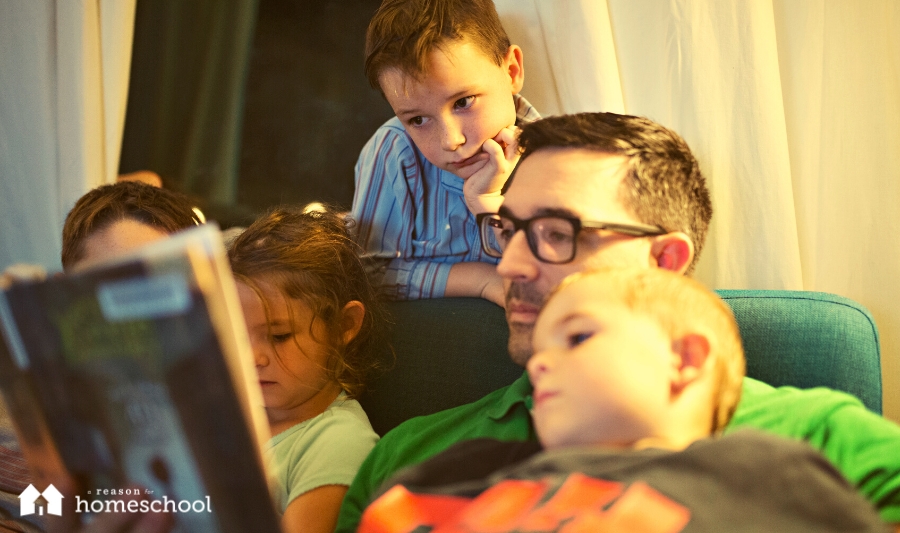Did the title sound odd? HOW to read aloud? We hear lots of whys to read aloud and certainly lots of whats to read aloud, but when it comes to how … don’t we just open the book and start reading?
Please stay with me. I hope to convince you that the HOW is indeed as important as the why and what of reading aloud.
First let’s talk about the who. Reading aloud is not only for preschoolers, pre-readers, and early readers. We kept a family read-aloud going through the high school years. Our read-aloud time was often right after dinner. Because I seemed to eat more quickly than everyone else in the family, picking up the read-aloud book was a way for me to avoid serving myself seconds when I really was already full.
No matter what age or stage, reading aloud creates shared memories and special bonds. Together we are time travelers – going to places in history to meet both famous and fictional characters. We travel geographically to places we may never travel on our own. We laugh, cry, and collectively hold our breath. The children beg for one more chapter and, putting off the dishes a few more minutes, I happily oblige. We move from the kitchen table to the sofa. Chore time and bedtime are both delayed.
Here are some of my HOWS for reading aloud (and I hope you will add some of your own in the comment section below):
- Snuggle up
Some of my more precious memories of child rearing are reading aloud with children on both sides leaning on and staying close. Covering up with an afghan or throw makes it all the nicer. And if it’s winter and the fire is going … ahhhh … it doesn’t get any better! - Give credit where credit is due.
Before turning to page 1, read the title and the author. All too often we remember the name of the book, but not the person who wrote it. The person who took the time to labor over this masterpiece we are about to enjoy needs to be acknowledged. If you read the title and the author every time you open this book (not just the first time), both you and your children will remember. - Note the date.
Open first to the copyright page. Point out the date and then put it in context. For example, “This book was written in 1952. Your great grandma was 10 years old. Let’s ask her if she read it when she was a little girl.” Or, “This book was published in 1950. That was five years after World War II ended.” The copyright date may spark some interesting national, world, or even family event discussions. - Savor the opening.
The opening of any piece (speech, blog, magazine article, book, etc.) can be the most difficult to craft. The beginning needs to grab the attention of the reader. The good ones spark curiosity and spur us on to keep reading. My all-time favorite is E.B. White’s opening to Charlotte’s Web: “Where’s Papa going with that ax?” said Fern to her mother as they were setting the table for breakfast. - Don’t just chase the storyline.
While we all love a page turner and the thrill of learning “what happens next,” there’s much to be gleaned from not just what happens but how the story is told. Take the time to point out a well-crafted sentence – does the author open with a gerund or dialogue in lieu of a subject-then-verb order. Note word choices for precision and description – monumental trumps big and sauntered is a better descriptor than walked. And be sure to highlight all the literary devices: metaphors, similes, and personification. - Consider a quote journal.
The sentences that truly wow us should be captured. We tend to remember what we write, so these may be hidden away to be make their way into conversations or even future essays (where your child will, of course, add the appropriate footnote). - Read with passion.
You need not be a Thespian to do the voices – simply read with passion and add excitement to the story. Let your eyes, face, and voice convey your engagement and it will be contagious to your listeners.
From my early days of child rearing, I prayed my children would love to read and have an abiding intellectual curiosity. My desire was also for each to become a good communicator. I’m convinced that writing and speaking well begins with reading. Because I was never taught to communicate effectively through writing, I learned to write along with them. I figured out that the best way to learn was to observe good writing. Today I can happily say all four students have surpassed their writing teacher.
I’d like to invite you to view this recent Martha Monday video on my ministry YouTube channel, where I unpack some of the items discussed above. You’ll also find a free download there for a list of a few of our family’s favorite read-alouds!

